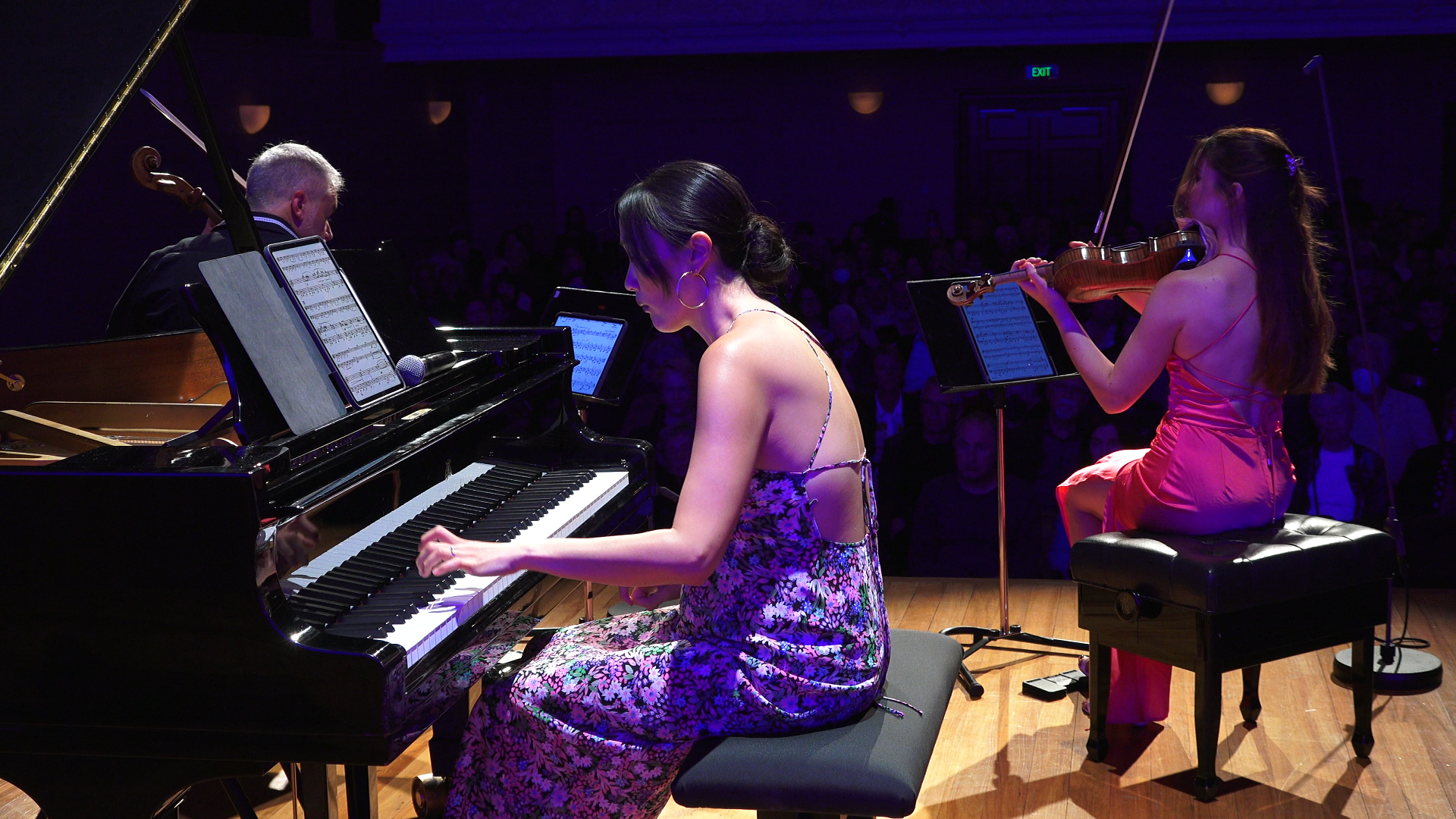Everything was beautifully matched: the bowing techniques, the dynamics, the tones, the passing of melodies from one instrument to another. Their communication with one another seemed instinctive, and the instruments blended seamlessly into an organic whole.
– Anne Bovett, Taranaki Music Reviews
TwinePieces
NZTrio gave a stunning performance of “TwinePieces”, their new programme of five works, last night in the Len Lye Gallery at the Govett Brewster Art Gallery.
Founder member and cellist Ashley Brown was joined by new members Amalia Hall (violin) and Somi Kim (piano), replacing retired former members, Justine Cormack and Sarah Watkins. It might have been a new line-up, but these musicians (each a multiple award-winner with outstanding lists of achievements) played as if they had been working together for years. Everything was beautifully matched: the bowing techniques, the dynamics, the tones, the passing of melodies from one instrument to another. Their communication with one another seemed instinctive, and the instruments blended seamlessly into an organic whole.
The emotional link between the performers was matched by the intimacy with the audience. We seemed close enough to touch them (indeed, I was closer to the strings than I am when I play in an orchestra), yet the generous acoustics of the gallery blended the sound and delivered it just perfectly. Ashley demonstrated how resonant the room was with many echoes from a single clap, and in some circumstances that would be difficult to work with, but for the trio it was ideal.
[As a footnote, some of us wondered why the staff didn’t turn off the audio exhibits in the neighbouring galleries, which were slightly distracting, with ghostly sounds or burst of conversation at inopportune moments. The answer was, they did their very best, but apparently it takes a cherry-picker to get to the roof cavity to do so! In the end, you just accepted it as part of the ambience and the experience.]
The trio have embraced new technology, in the form of tablets and foot pedals in the place of shuffled pages of music and hurried page turns. You can see its appeal, and it is likely to be the way of the future.
The programme was a well-chosen mix of the new and the familiar. The opening work “Mishima” by Philip Glass was much less challenging for the audience than one might anticipate. The trio made the “repetitive structures” always interesting, with variations of tone and dynamics, and the shifts to melodic interludes always came just in time, giving a really appealing and moving short piece.
Then we had the first movement of Robert Schumann’s Piano Trio in F major. It is marked “very lively” and it certainly was. There were gorgeous, romantic melodies shared between the instruments, moments of great passion and intricate textures. The ensemble was immaculate, and we admired in turn the glorious depth of tone in the cello, the warm, rich singing of the violin and the virtuosity brought to the piano part.
Next was “Rush” a piece by Australian composer Matthew Hindson. Apparently it was inspired by both the spirit of Mendelssohn’s string writing and techno music. Certainly the latter was discernible. I confess I am not as familiar as I should be with Mendelssohn’s later string works, and lack a degree in music, so the reference rather passed me by. It seemed to me to be closer to bluegrass and country. At some points Ashley Brown looked to be channelling the 2 Cellos’ version of heavy metal pieces (with a lot more finesse and a lot less damage to his bow). It was a demanding piece for audience and players, fast and furious, with dramatic climaxes, made exciting by the superb execution by the trio, and it garnered great acclaim from the audience.
A new commission by young New Zealand composer, Celeste Oram, was a blend of music and performance art, involving the audience providing written phrases which were randomly chosen and read out by the players, as well as the players drinking a toast and distributing flowers, linking to the theme of a burial at sea. Rice (?) was poured into a container on the piano keyboard, giving the sound effect of the sea as well as the visual effect of the scattering of ashes. The strings provided the sound of seagulls with descending scales and glissandi. There were poignant moments, and overall the piece was successful (probably more so if you are not the sort of person, like me, that gets distracted worrying what damage stray grains of rice might do to the piano keyboard).
The final work, the Brahms Piano Trio in B major, was everything you would want it to be. The composer was in his early twenties when he wrote it, but he revised it decades later. We could relax into the comforting familiarity of Brahms’ distinctive style, the glorious melodies played with expert technique and deep feeling by these consummate musicians. There were emotional outbursts contrasting with tenderness and peace, lively dances and lyrical passages. The tumultuous final movement still had moments of blissful calm. It was the perfect end to an outstanding concert.
Anne Bovett, New Plymouth
Taranaki Music Reviews

